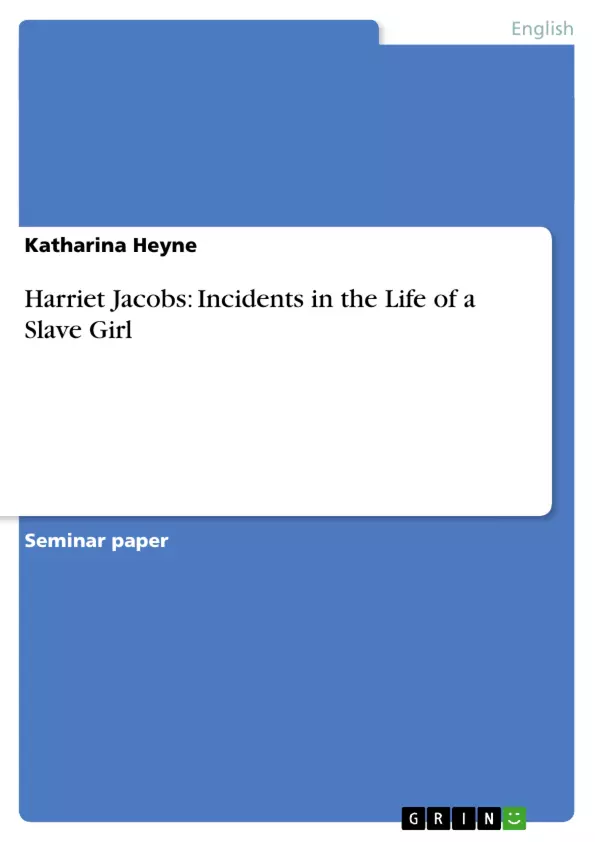In dieser Seminararbeit behandele ich Harriet Jacobs' "Incidents in the Life of a Slave Girl". Dabei wird das Werk einer genaueren Analyse unterzogen, um es literaturtheoretisch einordnen zu können. Dabei werden unter anderem die amerikanische Autobiographie sowie der slave narrative näher dargestellt.
'Incidents' ist ein slave narrative der besonderen Art, da er von einer Frau geschrieben wurde, die ganz anderen Reaktionen ausgesetzt war wie ein Mann in der damaligen Zeit. Dies wird auch in meiner Analyse deutlich.
Inhaltsverzeichnis (Table of Contents)
- I. Introduction
- II. Definition of the term Autobiography
- III. Types of Autobiographies
- 1. Slave Narrative
- 2. Franklin's Autobiography
- 3. Sentimental Novel
- IV. Harriet Jacobs's Incidents in the Life of a Slave Girl
- 1. The Historical Person of Harriet Jacobs
- 2. Olney's Masterplan
- a. The Role of a Female Slave
- b. Social Criticism - the Myth of the “Southern Belle and the
- c. Conclusion on Olney's Masterplan
- 3. Comparison between Benjamin Franklin and Harriet Jacobs
- V. Conclusion
Zielsetzung und Themenschwerpunkte (Objectives and Key Themes)
This term paper aims to analyze Harriet Jacobs’s “Incidents in the Life of a Slave Girl” within the broader context of American autobiographies. It examines the specific characteristics of slave narratives and their position within the genre of autobiography. The paper investigates how Jacobs’s work embodies key themes of the sentimental novel, using it as a tool for social commentary on the hypocrisy of the American South and the brutal reality of slavery.
- The evolution and definition of the term "autobiography" and its application to slave narratives
- The role of the "Master Plan" in shaping the narrative structure of slave narratives
- The intersection of the sentimental novel and slave narratives in the work of Harriet Jacobs
- The social and political critique embedded within Jacobs’s work
- A comparative analysis of Harriet Jacobs’s "Incidents" and Benjamin Franklin's autobiography
Zusammenfassung der Kapitel (Chapter Summaries)
The paper begins by defining the term "autobiography" and exploring its historical development. It then analyzes different types of autobiographies, including the slave narrative, focusing on the defining characteristics of each genre. The discussion delves into the specific features of the slave narrative, including the "Master Plan" proposed by James Olney, which outlines a set of conventions common to this type of narrative.
The main body of the paper examines Harriet Jacobs's "Incidents in the Life of a Slave Girl." The analysis explores the historical context of Jacobs's life and investigates the role of the sentimental novel in shaping her narrative. The paper highlights the social critique embedded within her work, examining how she uses the conventions of the sentimental novel to expose the hypocrisy of the American South and the brutal reality of slavery.
The paper also compares Jacobs's autobiography to that of Benjamin Franklin, highlighting the similarities and differences between their respective narratives and their approaches to autobiography.
Schlüsselwörter (Keywords)
The key terms and concepts explored in this paper include: American autobiography, slave narrative, sentimental novel, Harriet Jacobs, “Incidents in the Life of a Slave Girl,” Benjamin Franklin, Olney's Masterplan, social critique, Southern Belle, "peculiar institution," and hypocrisy of paternalism. This paper delves into the complex intersection of these themes and analyzes the ways in which they shape the narrative structure and social commentary present in Jacobs's work.
- Citation du texte
- Katharina Heyne (Auteur), 2004, Harriet Jacobs: Incidents in the Life of a Slave Girl, Munich, GRIN Verlag, https://www.grin.com/document/38520



